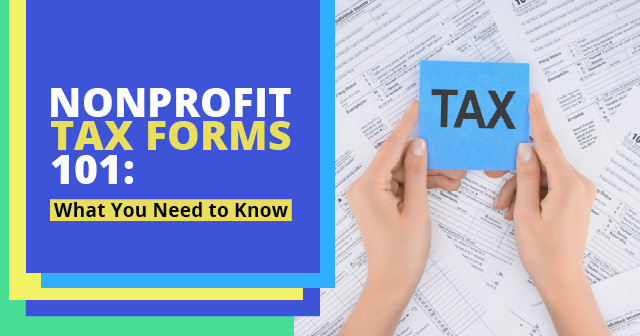
Nonprofit Tax Forms 101: What You Need to Know
September 22, 2022
You may think being a registered nonprofit means you’ll never have to file taxes. Well, not quite. Despite qualifying for tax exempt status, nonprofits are required to submit tax forms every year, providing a level of detail about their finances over the year.
Qualifying for Tax Exempt Status
Your organization can have charitable intentions, actions, and invest your money solely for the purpose of your mission, but without the proper paperwork you won’t be registered as an official tax exempt charitable organization, or have 501(c)(3) status.
Federal Submissions
As soon as your nonprofit is established, your nonprofit should submit a Form 1023, to register as an official 501(c)(3) for federal tax exempt status. Once your charitable organization is registered, you are no longer required to pay federal income tax, which helps boost your revenue.
Your tax exemption will remain in effect as long as you submit an annual Form 990—your required tax form. This form simply helps the IRS ensure others aren’t taking advantage of the system by requiring all organizations to submit financial information on a regular basis.
State Submissions
Commonly, your federal 501(c)(3) registration covers your tax exemption status for both the federal and state governments. However, there can be secondary documentation required for state tax filing if your state doesn’t automatically exempt your organization from income and sales taxes with a 501(c)(3) status.
For most states, a federal approval of 501(c)(3) status automatically applies for state income tax exemption status. Research your state’s requirements, to verify that your nonprofit has state income tax exemption. If not, you may need to submit an exemption request to the state Department of Revenue for registration.
If your nonprofit often hosts product fundraisers, merchandise, hosts auctions frequently, purchase items for events, or has sales-based fundraising strategy, you may also be eligible for sales tax exemption. Sales tax exemption is not commonly an automatic privilege associated with 501(c)(3) status, so be sure to research your state Department of Revenue policies—you could be missing out on saving money!
Filing Tax Forms
All 501(c)(3) registered charitable organizations must submit an annual Form 990, to maintain their status. This form essentially assures the IRS that your organization complies with tax exemption standards. Be sure to check if your state also requires you to submit your Form 990 to your state Department of Revenue annually as well.
There are several versions of the Form 990, which vary in complexity depending on your organization’s gross annual income bracket. All versions of the form require proof of income and most require a balance sheet, so it is important to keep your financial records.
After your fiscal year, you’ll want to pull financial statements to review the year’s activities, comparing your balance sheet and budgeting document for any misalignments. Pulling these reports will also help you fill out the information on your Form 990. For example, your statement of functional expense will organize your expenses in the same categories as required on the tax forms.
To avoid filing the wrong Form 990 (or doing more work than is required of you), evaluate your annual gross receipts to identify any large fluctuations in income that may place you in a different Form 990 category. This step is also helpful to identify potential growth areas for your organization such as major gifts, recurring donations, or matching gifts programs.
You may discover that your organization must file the standard Form 990, or that you qualify to complete a shorter, simpler form. The forms you have to choose from are the Form 990-N, 990-EZ, and the standard 990.
Form 990-N
Form 990-N, also called the e-postcard, is the most simplistic version of Form 990. Organizations with annual gross receipts of less than $50,000 qualify to file this form. You can submit this form online with the basic Form 990 information:
- Employer Identification Number (EIN)
- Taxpayer Identification Number (TIN)
- Year of filing
- Your organization’s name and address
- Your leadership’s names and addresses
- Your website URL
- Proof of gross annual receipts
Form 990-EZ
The Form 990-EZ is for organizations with annual gross receipts between $50,000 and $200,000. This form requires more in-depth information about your finances such as your:
- Revenue, expenses, and net assets
- Balance sheets
- Description of your yearly initiatives’ achievements
Organizations that qualify for the Form 990-EZ may not be able to afford a dedicated in-house accountant to complete the form. Luckily, with the right tax form resources and information about the form, your nonprofit will be able to file this form all on your own. File 990’s guide provides a step-by-step walkthrough for filing a Form 990-EZ including information about:
- Required financial information
- Locating your financial information
- E-filer software integrations
Be sure to keep an eye out for any additional schedules that you may be required to fill out as a part of your 990-EZ.
Form 990
The standard Form 990 is required for all nonprofits with total gross annual receipts greater than or equal to $200,000 or if the value of your total assets is $500,000 or more. This form is the most complex and usually completed by large organizations. It requires detailed information about your leadership team, funding usage, and organization accomplishments.
Keep in mind that no matter which form you file, your Form 990 will become publicly accessible. This means you should avoid adding unnecessary sensitive information to the form, such as social security numbers. As many donors will look up these forms to get an idea of your financial management before they donate, you may also consider making their lives easier by publishing an annual report releasing your financial information in another format.
By releasing this information in another format, you’ll actually bolster donor relationships further. Access to your report will make the donor journey easier, increase your financial transparency with donors, and allow you to add context behind the numbers you share. This additional context isn’t possible on your Form 990, but can make a big difference for your donors’ opinions! Suddenly, your tedious tax information can become a marketing tool for your organization.
Incomplete Form 990s
If you submit the wrong type of Form 990 or did not fill in all of the necessary information, the IRS will send you a letter to request you resubmit your form with corrections.The letter number will be in the upper right corner of the IRS documentation, each number requests different information returned such as
- Letter 2694C. Requests you return Form 990 because of missing Information
- Letter 2695C. Requests you return Form 990-EZ because of missing Information
- Letter 2696C. Requests missing information to process EO return
To remedy your incomplete submission, return the letter within 10 days of receipt with a reasonable cause for why the full information was not originally included. Be sure to include why you did not submit the form 8868 for an extension on your initial submission, how you practiced due diligence, and how you will avoid this mistake in the future.
Meeting Deadlines
Submitting your tax forms on time is crucial to your nonprofit tax exemption status. Your annual deadline will always be the 15th day of the 5th month after your fiscal year ends. If your fiscal year ends as the calendar year ends in December, then your deadline will be May 15. Or, if your fiscal year ends at the end of June, then your deadline will be November 15.
For every day past the deadline for submitting your Form 990, you can be penalized $20 a day for up to $10,000 or 5% of your gross annual receipts—whichever is less. Larger organizations that made more than $1,000,000 over the year experience even heavier penalties of $100 per day or 5% of their gross annual receipts.
If you fail to submit your Form 990 for 3 consecutive years, then you will no longer be registered as a 501(c)(3) and your organization will need to refile for tax exempt status. You will then be subject to federal income tax for your organization’s revenue.
All of this being said, submitting your Form 990 on time is key to your tax exemption status. If you are uncertain that you can meet the deadline, then your organization can submit a Form 8688 to request a 6 month extension of your due date. The IRS is happy to grant an extension, as they prefer this over you missing the deadline.
Nonprofit tax forms don’t have to be stressful. Using e-filer software can save you time and frustration when submitting your Form 990. This type of solution will remind you of the tax deadline, allow you to compile your nonprofit chapters’ filings, and guide you through submitting your own filing so you don’t miss any required information. Whether you file through an e-filer or submit your form yourself, just be sure you remember your tax form deadlines to ensure your tax exempt status remains active!
Get The Latest Updates
Subscribe To Our Monthly Newsletter
No spam, notifications only about new products, updates.
Become a subscriber
Subscribe to our blog and get the latest updates straight to your inbox.

